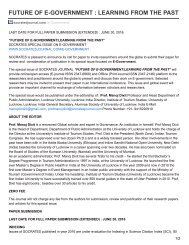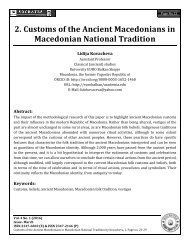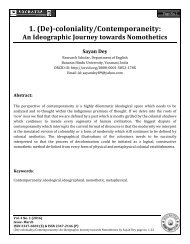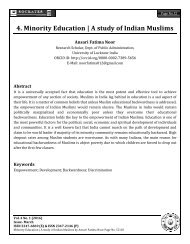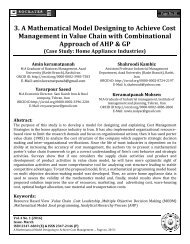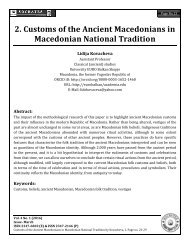Imaginative journeys: Connecting God....Einstein and Shankardeva.
Rakesh, P. (2016). Imaginative journeys: Connecting God....Einstein and Shankardeva. S O C R A T E S, 4(1), 61-64. Retrieved from http://socratesjournal.com/index.php/socrates/article/view/200 For more citation formats, visit: http://socratesjournal.com/index.php/socrates/rt/captureCite/200/0
Rakesh, P. (2016). Imaginative journeys: Connecting God....Einstein and Shankardeva. S O C R A T E S, 4(1), 61-64. Retrieved from http://socratesjournal.com/index.php/socrates/article/view/200
For more citation formats, visit:
http://socratesjournal.com/index.php/socrates/rt/captureCite/200/0
Create successful ePaper yourself
Turn your PDF publications into a flip-book with our unique Google optimized e-Paper software.
Book Review<br />
Page No.61<br />
5. <strong>Imaginative</strong> <strong>journeys</strong>:<br />
<strong>Connecting</strong> <strong>God</strong>....<strong>Einstein</strong> <strong>and</strong> <strong>Shankardeva</strong><br />
Prof. (Dr.) Rakesh Ch<strong>and</strong>ra<br />
Professor, Department of Philosophy<br />
University of Lucknow, India<br />
ORCID iD: http://orcid.org/0000-0003-2533-4894<br />
E-Mail: rakeshphilosophy@yahoo.com<br />
About the Book:<br />
<br />
<br />
Title of the Book: <strong>God</strong> <strong>Einstein</strong> <strong>and</strong> <strong>Shankardeva</strong><br />
Author: Shri. Surendra Nath Bora<br />
About the Author:<br />
<br />
Shri. Surendra Nath Bora is a film producer <strong>and</strong> award winning writer. He has keen interest in<br />
Religion, Spirituality <strong>and</strong> Metaphysics. He is also Chairman of the Sankardev Mission, Kamrup<br />
(M) Guwahati-781005 (Assam) Mobile: 9435100316, E-Mail: shankardevmission@gmail.com<br />
The Review:<br />
While some of us grow up with the belief in inescapable conflict of religion <strong>and</strong> science there is<br />
evidence in both ancient Greece <strong>and</strong> India where the division between scientific <strong>and</strong> humanistic<br />
culture was not maintained. There were those who accepted a principle of orderliness in all possible<br />
domains of experience from cosmology to music <strong>and</strong> mathematics in The Pythagorean spirit <strong>and</strong> in<br />
acceptance of ‘rta’. In India mathematical theories have been written in verse <strong>and</strong> after the term for<br />
the poet kavi is used as a synonym for the Philosopher Darshanik. Brilliant contemporary scholars<br />
like Prof. D.P. Chattopadhyaya, Prof. G.C. P<strong>and</strong>ey, Prof. Jayant Vishnu Narliker, Prof. A. Rahman,<br />
Prof. Projit Basu <strong>and</strong> others have in the past two <strong>and</strong> half decades specially highlighted the point that<br />
Philosophy, science, technology <strong>and</strong> culture are in-fact an interwoven fabric of human civilization<br />
<strong>and</strong> their speciation, differentiation or compartmentalization is mainly due to theoretical need for<br />
Vol. 4 No. 1 (2016)<br />
Issue- March<br />
ISSN 2347-6869 (E) & ISSN 2347-2146 (P)<br />
<strong>Imaginative</strong> <strong>journeys</strong> <strong>Connecting</strong> <strong>God</strong>... Prof. (Dr.) Rakesh Ch<strong>and</strong>ra Page no. 60-64
Page No.62<br />
specialization. It is interesting that a response of awe <strong>and</strong> wonder at the beauty <strong>and</strong> charming<br />
complexity of the universe is not uncommon among scientists who see religious implications in the<br />
intelligibility of the world. As religion seeks meaning <strong>and</strong> purpose in the interpretation of our being<br />
in the world, science helps us to find regularities.<br />
In India, an ambitious project of History of India, Science, Philosophy <strong>and</strong> culture was<br />
inlisted in 1996 <strong>and</strong>, in 1995 an ambitious programme of Dialogue in science ethics <strong>and</strong> religion was<br />
established within the most prominent organization of American Scientists, American Association for<br />
the Advancement of Science (AAAS). It is interesting that average number of books published<br />
annually in the United States <strong>and</strong> listed under the Library of Congress heading “Religion <strong>and</strong> Science”<br />
tripled from the 1950’s to the 1990’s. It is interesting to note that many Scientist see their quest as a<br />
spiritual quest <strong>and</strong> several physicists see religious implications in the fine tuning of the parameters of<br />
the] early universe. Some scientists combine practices of Zen Buddhism with Judaism. Scientists like<br />
Francisco Ayala, Avro penrias, Pauline Rudd, Mehdi Galshami, Kenneth Kendler, Charles Townes in<br />
their interviews published in 2001 under the title ‘Faith <strong>and</strong> Science by Routledge’ wonderfully<br />
escaped their instinct of how they see their insight of how they see their scientific <strong>and</strong> spiritual quest<br />
as continuous.<br />
Mr. Surendra Nath Bora has made an attempt to bring to the larger audience a translation of<br />
Shri. Sankardeva’s original III canto of Assamese ‘Madhagvata’ with a forward where he connects his<br />
own reading of religion, philosophy <strong>and</strong> science together. The work is an article of faith where the<br />
author has selectively <strong>and</strong> imaginatively reconstructed the histories of philosophy <strong>and</strong> science to<br />
build a case for his own interpretation.<br />
The translation of the work Sankardev for the English reading people is useful where the<br />
Bamanpurana <strong>and</strong> the Bhagwat epic have been put together.<br />
The book has carefully put the original verses of the text in Roman together with his own<br />
translation <strong>and</strong> rates. There are also beautiful illustrations where the author <strong>and</strong> translator tries to<br />
show scientific parallels for example it is stated that the measure of the serpent hood mentioned as<br />
38.88 Cr. Km is comparable with Higgs field. Further 24 theories of gross elements that created the<br />
universe, the mind maps, creation of under-earths, classical zodiac systems, limits of the union of<br />
universal dissolution <strong>and</strong> many other imaginative metaphysical accounts are shown to have scientific<br />
parallels in geophysics, astrophysics <strong>and</strong> cosmology.<br />
The author/translator Shri. Surendra Nath Bora has earlier translated Bhagwat in the<br />
context of social science with reference to international scientific socialism <strong>and</strong> European<br />
Vol. 4 No. 1 (2016)<br />
Issue- March<br />
ISSN 2347-6869 (E) & ISSN 2347-2146 (P)<br />
<strong>Imaginative</strong> <strong>journeys</strong> <strong>Connecting</strong> <strong>God</strong>... Prof. (Dr.) Rakesh Ch<strong>and</strong>ra Page no. 60-64
Page No.63<br />
Renaissance. It is interesting that he decides to translate the idea of ‘Jagannath Adi Mul’ as active Zero<br />
Lord Krishna who created the Earth Brahma <strong>and</strong> other <strong>God</strong>s.<br />
Indians are credited with the discovery of zero while the creeps thought it would be a<br />
contradiction to introduce it as something which was nothing. Brohmagupta in 628 A.D.decided to<br />
define zero <strong>and</strong> from then we have an elegant mathematical system.<br />
However some recent scholars like Kuruvilla P<strong>and</strong>ikattu in the science religion dialogue call<br />
attention to some key features of absolute zero. Absolute zero is the oldest possible temperature<br />
where particles are at absolute rest but this is unattainable.<br />
The Heisenberg uncertainty principle assets that even at minimum temperature there will be<br />
residual kinetic energy. The third law of Thermodynamics also shows the limits.<br />
P<strong>and</strong>ikattu says that what can be said of heat can also perhaps be said for the heart – the<br />
realm of love <strong>and</strong> relationship. Zero is the realm of infinity, fullness <strong>and</strong> unattainably.<br />
Surendra Nath Bora’s work is a work of a well meaning enthusiast who tries to see<br />
commonalities in the cross cultural, cross disciplinary efforts of mankind to explain reality <strong>and</strong> find<br />
meaning. The reading of history of science <strong>and</strong> philosophy however leaves much to be desired. It is<br />
well to look at Spenaiza <strong>and</strong> <strong>Einstein</strong> together for comparison but to put two men who were<br />
centuries apart as friends is factually incorrect. Many references to theories attributed to scholars<br />
also require proper referencing.<br />
The major question to be addressed however is- the scientific method <strong>and</strong> the imaginative<br />
speculative method <strong>and</strong> the intuitive declaration fall in the same category with reference to what<br />
philosophers call valid knowledge? We may all hit at truth by chance but will we be said to be in<br />
possession of knowledge if our evidential position is different. There are certainly remarkable<br />
parallels between ancient accounts of cosmology <strong>and</strong> modern science but it would perhaps be hasty<br />
to say that the ancestors were in possession of the same knowledge.<br />
The work can be seen as an interesting contribution to imaginative cultural studies where<br />
traditional indigenous works are made available to the modern reader to see <strong>and</strong> examine what use<br />
she can make of these poetic, metaphoric texts for our present purpose.<br />
Reviewers Rating:<br />
Vol. 4 No. 1 (2016)<br />
Issue- March<br />
ISSN 2347-6869 (E) & ISSN 2347-2146 (P)<br />
<strong>Imaginative</strong> <strong>journeys</strong> <strong>Connecting</strong> <strong>God</strong>... Prof. (Dr.) Rakesh Ch<strong>and</strong>ra Page no. 60-64
Page No.64<br />
Cite this article:<br />
<strong>Imaginative</strong> <strong>journeys</strong>: <strong>Connecting</strong> <strong>God</strong>....<strong>Einstein</strong> <strong>and</strong> <strong>Shankardeva</strong><br />
Citation Format: APA<br />
Rakesh, P. (2016). <strong>Imaginative</strong> <strong>journeys</strong>: <strong>Connecting</strong> <strong>God</strong>....<strong>Einstein</strong> <strong>and</strong> <strong>Shankardeva</strong>. S O C R A T<br />
E S, 4(1), 61-64. Retrieved from<br />
http://socratesjournal.com/index.php/socrates/article/view/200<br />
For more citation formats, visit:<br />
http://socratesjournal.com/index.php/socrates/rt/captureCite/200/0<br />
Indexing metadata is available online on:<br />
http://socratesjournal.com/index.php/socrates/rt/metadata/200/0<br />
Vol. 4 No. 1 (2016)<br />
Issue- March<br />
ISSN 2347-6869 (E) & ISSN 2347-2146 (P)<br />
<strong>Imaginative</strong> <strong>journeys</strong> <strong>Connecting</strong> <strong>God</strong>... Prof. (Dr.) Rakesh Ch<strong>and</strong>ra Page no. 60-64





